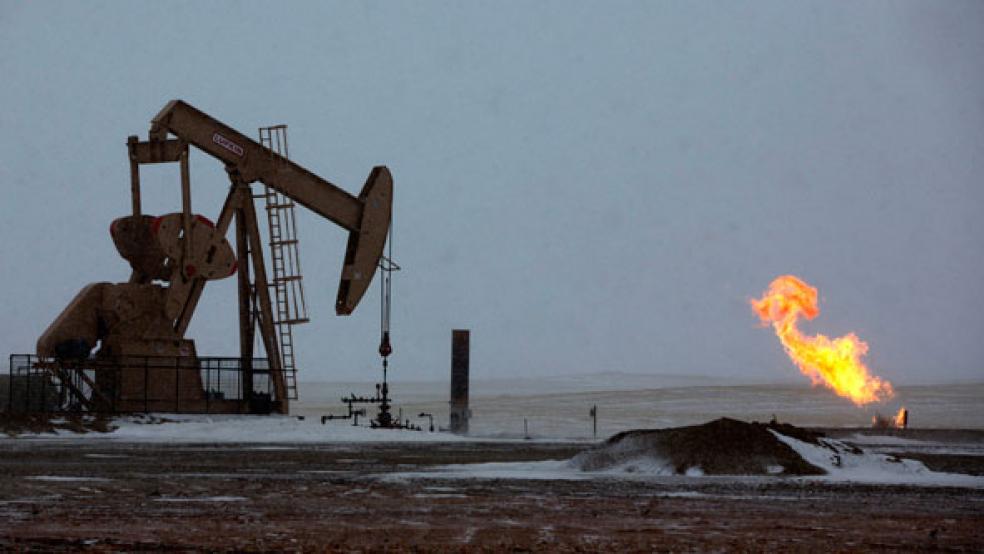Oil producers rejoice! Finally, the end seems to be in sight for one of the worst global oil glut in history.
Phil Flynn, senior energy analyst at PRICE Future Group, says a new bull market is emerging in the global economy after “one of the ugliest bear markets we’ve seen,” and he anticipates prices to get close to $70 a barrel by the Fourth of July.
Oil prices have plunged almost 70 percent over the past 20 months, largely caused by oversupply. Major oil producing countries like Saudi Arabia have refused to cut production amid slowing demand from Europe and China, even as their own economies have taken massive hits.
Related: 5 Conspiracy Theories About the Oil Crash, from Ludicrous to Logical
Now, most countries seem to be ready to play nice and work together to boost prices. Oil prices have soared almost 40 percent since prices hit 13-year lows less than two months ago to below $27 a barrel. Recent data shows that the U.S. rig count fell for the 11th straight week.
Here are the four main reasons behind the recent rally that Flynn says are evidence that the bottom is finally here:
U.S. oil companies are cutting production
After months of job cuts and slashes in budgets, many U.S. oil companies are finally choosing to cut production. Most companies are planning to pump 10 to 30 percent less than expected. According to Flynn, the barrels of oil produced in the U.S. could fall from 9 million barrels a day to as little as eight million by this summer.
Flynn adds that even if oil prices rise over the next few months, companies aren’t going to be able to just head back into the oil fields and tap into new wells. They’ve already cut the spending for these projects and are deeply in debt. Roughly one third of oil companies are expected to declare bankruptcy this year, according to a Deloitte report.
OPEC and non-OPEN countries finally agree to freeze production
Countries that produce 73 percent of the world’s oil have agreed to a tentative deal to freeze production, according to Russia’s Energy Minister Alexander Novak. Officials from OPEC and non-OPEC countries anticipate limiting their output to January levels and are currently in talks for how to monitor the freeze. An OPEC meeting with Russia is planned for later this month to solidify the agreement.
Related: Why Oil Prices Will Rebound in 2016
Even though not all of the countries have good diplomatic relations, Flynn doesn’t see that causing much of an impact because oil carries more weight at this point. “Everybody is on their knees right now,” Flynn says. “Nobody can afford to play this game anymore.” Even Saudi Arabia, the country that is supposed to be able to best ride out an oil bust, just asked banks for an international loan, totaling around $10 billion. The rating agency Standard & Poor also downgraded the Middle Eastern country’s credit rating last month to A- stable rom A+ negative. The agency cited pressures stemming from the oil price drop as the reason behind the move.
Iranian oil isn’t that big a deal
The idea of Iranian oil entering the market once sanctions were lifted motivated many oil-producing countries to keep pumping oil at record paces to prevent losing market share. But now that Iranian oil is ready to enter the market, the “problem is that companies don’t have the money to invest. Production increases in Iran will be slower than expected,” Flynn says.
Even if Iran is able to ramp up production, “there is going to be some wiggle room” from other oil producers for Iran to produce more oil, Flynn says. Iran and Saudi Arabia have no diplomatic relations, but “nobody is in good shape and nobody can keep playing this game.” An Iranian official said that the country would consider production cuts once the country is producing at levels seen before the sanctions were imposed.
Related: Oil Ends Down on Profit-Taking but Still Up Strongly on Week
China isn’t that much of a concern
An economic slowdown in the world’s largest oil importer isn’t actually hurting the oil economy as much as anticipated. There was the initial fear that “China’s demand would fall off a map and that the country would be in a total meltdown, but we’ve seen some stability in the Chinese market and even though demand is questionable, imports have stayed near record highs,” says Flynn.
According to a Platts China Oil Analytics report, oil demand in China grew by 5.8 percent in 2015, up from 4.7 percent the year prior. Demand is expected to slow this year to 2.7 percent, due to an anticipated decline in GDP growth.
Downbeat manufacturing and service sector data released this week raised hopes of the Chinese government implementing additional stimulus measures. The country also just announced that it cut the amount of money that banks must hold as reserves for the fifth time this year. Even though these signs give investors hope that the Chinese economy is turning around, there’s always the possibility that the economy will sink deeper into depression and demand for oil will plummet. “If the wheels come off the Chinese economy, all bets are off,” Flynn says.





